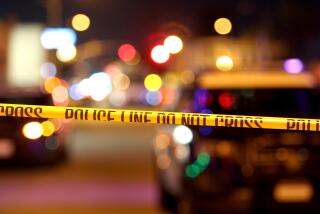3 Fatal Shootings in Single Night Shatter Rare Compton Calm
- Share via
For more than three weeks, the streets of Compton were unusually quiet, inexplicably so. Everyone knew that the relative peace would end; the only question was when. And early Friday, it did--with a vengeance--as gunfire left three men dead within a three-hour span.
Hours later, Compton homicide investigator Jack McConnell sat slumped at his desk, a phone on his ear and a pen in his hand. On the line was an informant. On the floor were three half-empty bottles of soda, which the bleary-eyed cop was logging into evidence.
For McConnell, who had been summoned to work before dawn, the morning marked a hideous return to normal after a most unusual period for the community: 25 days without a murder.
“There’s no rhyme or reason to it,” said McConnell’s boss, Police Lt. Percy Perrodin, as he perused the department’s homicide log. “There has been a lull--but for not that long a period. . . . It comes and it goes. You never know.”
In many communities with fewer than 100,000 residents, it may be no big deal to go nearly a month without a murder. But most cities are not as violent as Compton, where homicides occur far more frequently than in either Los Angeles or Washington, D.C., which is commonly referred to by the media as the murder capital of America.
In Washington last year, authorities reported 58 homicides per 100,000 residents. In Compton, which has slightly fewer than 100,000 residents, 82 were killed in 1988 and another 84 the year before.
To put it another way--about one of every 1,100 Compton residents has fallen victim to homicide in each of the last two years. And this year, the murder rate is even more appalling: 32 homicides already.
During the nearly four-week murder respite, Perrodin’s five-man homicide squad had no problem remaining busy.
“Cases are open until they’re solved. . . . If you don’t solve it today, maybe then next week,” McConnell said. The squad also investigated one shooting, which was ruled a justifiable homicide, and logged the death in the hospital of a 14-year-old victim of a March shooting.
With the usual flurry of cases, files are temporarily set aside when detectives run out of fresh leads. But during the recent lull, McConnell said, “we (could) go back into cases that haven’t been solved and reopen those cases.”
The respite came to an end at two minutes past midnight, when Johnny Michael Lee, 40, was shot in the neck after an argument during a party in his apartment in the 1300 block of East Glencoe Avenue.
Assailant Flees
By the time patrol officers arrived, Lee’s assailant, as well as other party-goers, “had run out of the location and into the night,” Perrodin said.
And by the time homicide investigators Johnny Swanson and Bryant Gilbraith had been called to the scene, a second, unrelated murder had occured only blocks away.
At 12:15 a.m., authorities said, pedestrian Jimmy Michael Mapp, 32, was shot in the face after a yelling match with a motorist, who alighted from his vehicle, shotgun in hand. The incident in the 1300 block of South Long Beach Boulevard may have been narcotics-related, police said.
McConnell, along with Marvin Branscomb and Gilbert Cross, were summoned as a result of a third slaying at 2:45 a.m. in a dingy apartment building in the 1500 block of South Long Beach Boulevard. Authorities said Compton resident Donny Stalworth, whose age was not immediately known, was shot dead with a handgun during a drinking party in the apartment of Ray Johnson.
Host Also Shot
Johnson was himself shot in the chest after demanding that the suspect remove Stalworth’s body from his apartment, Perrodin said. He was hospitalized in serious condition.
Charles Goshen, 24, of Compton, was arrested outside the building moments later and booked on suspicion of murder, according to police.
Over the years, city fathers have blamed the high crime rate on poverty, the proliferation of drugs and the prevalence of street gangs.
Recent statistics show that more than 25% of Compton households receive welfare payments and that the estimated average household income in the city in 1988 was $23,196--far less than the $39,600 average countywide.
Officials have also blamed the skyrocketing murder rate on the easy availability of lethal weapons. In January, the City Council voted to ban AK-47s and other semiautomatic rifles.
More to Read
Sign up for Essential California
The most important California stories and recommendations in your inbox every morning.
You may occasionally receive promotional content from the Los Angeles Times.










